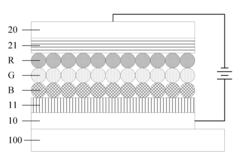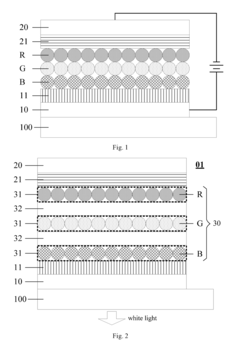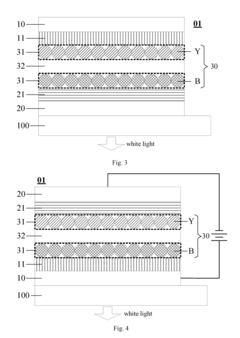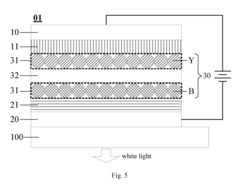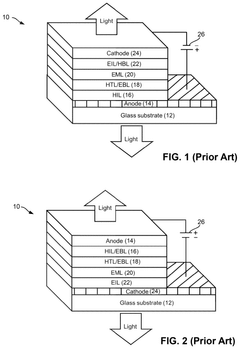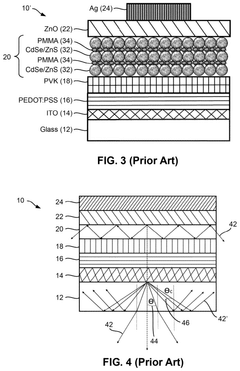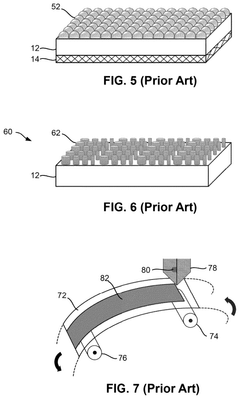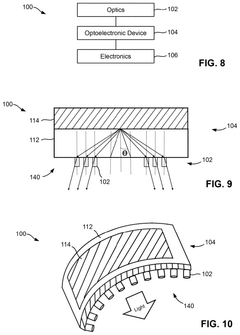QLED Applications: Expanding Horizons in Every Sector
JUN 20, 20258 MIN READ
Generate Your Research Report Instantly with AI Agent
Patsnap Eureka helps you evaluate technical feasibility & market potential.
QLED Evolution and Objectives
Quantum Dot Light-Emitting Diode (QLED) technology has emerged as a revolutionary force in display and lighting applications, marking a significant milestone in the evolution of visual technology. The journey of QLED began with the discovery of quantum dots in the 1980s, but it wasn't until the early 2000s that researchers started exploring their potential in display technology. The primary objective of QLED development has been to create displays with superior color accuracy, brightness, and energy efficiency compared to traditional LED and OLED technologies.
As QLED technology progressed, it addressed several key challenges in display technology. These included improving color gamut, enhancing brightness levels, and increasing energy efficiency. The evolution of QLED has been characterized by continuous improvements in quantum dot synthesis, integration techniques, and device architectures. This ongoing development has led to QLED displays that offer vibrant colors, deep blacks, and high contrast ratios, rivaling and in some aspects surpassing OLED technology.
The objectives of QLED technology extend beyond just enhancing display quality. A major goal has been to develop more sustainable and environmentally friendly display solutions. This includes reducing the use of rare earth elements and developing quantum dots that are free from heavy metals, addressing environmental concerns associated with electronic waste. Additionally, researchers and manufacturers have been working towards improving the lifespan of QLED displays, aiming to match or exceed the durability of other display technologies.
Another significant objective in QLED evolution has been to expand its applications beyond traditional display panels. This includes exploring its potential in flexible and transparent displays, opening up new possibilities in wearable technology, automotive displays, and smart home applications. The versatility of quantum dots has also led to research into their use in lighting solutions, solar cells, and even biomedical imaging, showcasing the technology's potential to revolutionize multiple sectors.
Looking ahead, the future objectives for QLED technology are ambitious and multifaceted. These include further enhancing color accuracy and brightness, reducing power consumption, and improving manufacturing processes to make QLED displays more cost-effective. There is also a strong focus on developing quantum dots that can be applied using solution-based processes, which could significantly simplify manufacturing and potentially lead to printable displays. As QLED technology continues to evolve, it is poised to play a crucial role in shaping the future of visual technology across various industries, from consumer electronics to healthcare and beyond.
As QLED technology progressed, it addressed several key challenges in display technology. These included improving color gamut, enhancing brightness levels, and increasing energy efficiency. The evolution of QLED has been characterized by continuous improvements in quantum dot synthesis, integration techniques, and device architectures. This ongoing development has led to QLED displays that offer vibrant colors, deep blacks, and high contrast ratios, rivaling and in some aspects surpassing OLED technology.
The objectives of QLED technology extend beyond just enhancing display quality. A major goal has been to develop more sustainable and environmentally friendly display solutions. This includes reducing the use of rare earth elements and developing quantum dots that are free from heavy metals, addressing environmental concerns associated with electronic waste. Additionally, researchers and manufacturers have been working towards improving the lifespan of QLED displays, aiming to match or exceed the durability of other display technologies.
Another significant objective in QLED evolution has been to expand its applications beyond traditional display panels. This includes exploring its potential in flexible and transparent displays, opening up new possibilities in wearable technology, automotive displays, and smart home applications. The versatility of quantum dots has also led to research into their use in lighting solutions, solar cells, and even biomedical imaging, showcasing the technology's potential to revolutionize multiple sectors.
Looking ahead, the future objectives for QLED technology are ambitious and multifaceted. These include further enhancing color accuracy and brightness, reducing power consumption, and improving manufacturing processes to make QLED displays more cost-effective. There is also a strong focus on developing quantum dots that can be applied using solution-based processes, which could significantly simplify manufacturing and potentially lead to printable displays. As QLED technology continues to evolve, it is poised to play a crucial role in shaping the future of visual technology across various industries, from consumer electronics to healthcare and beyond.
QLED Market Demand Analysis
The QLED (Quantum Dot Light-Emitting Diode) market has experienced significant growth in recent years, driven by increasing demand for high-quality displays across various sectors. The technology's ability to deliver superior color accuracy, brightness, and energy efficiency has positioned it as a preferred choice for consumers and businesses alike.
In the consumer electronics sector, QLED displays have gained substantial traction, particularly in the television market. The demand for larger screens with enhanced picture quality has fueled the adoption of QLED technology. Market research indicates that QLED TVs have been steadily increasing their market share, with consumers showing a strong preference for the vibrant colors and deep blacks offered by this technology.
The automotive industry has also emerged as a key driver for QLED market growth. As vehicles become more technologically advanced, there is a growing need for high-quality displays in dashboards, infotainment systems, and heads-up displays. QLED technology's ability to maintain visibility in bright sunlight and its durability make it an attractive option for automotive applications.
In the commercial and professional sectors, QLED displays are finding applications in digital signage, control rooms, and medical imaging. The technology's high brightness and color accuracy make it ideal for large-format displays in public spaces and for critical visualization tasks in industries such as healthcare and security.
The gaming industry represents another significant market for QLED technology. Gamers demand displays with high refresh rates, low input lag, and excellent color reproduction – all attributes that QLED screens can deliver. This has led to an increase in QLED gaming monitors and laptops, catering to both casual and professional gamers.
Looking at geographical trends, Asia-Pacific has emerged as the largest market for QLED displays, driven by the presence of major manufacturers and a large consumer base. North America and Europe follow closely, with strong demand in both consumer and commercial sectors.
The market demand for QLED technology is expected to continue its upward trajectory in the coming years. Factors such as decreasing production costs, technological advancements, and expanding applications across various industries are likely to fuel this growth. As QLED technology evolves, it is anticipated to find new applications in emerging fields such as augmented reality (AR) and virtual reality (VR), further expanding its market potential.
In the consumer electronics sector, QLED displays have gained substantial traction, particularly in the television market. The demand for larger screens with enhanced picture quality has fueled the adoption of QLED technology. Market research indicates that QLED TVs have been steadily increasing their market share, with consumers showing a strong preference for the vibrant colors and deep blacks offered by this technology.
The automotive industry has also emerged as a key driver for QLED market growth. As vehicles become more technologically advanced, there is a growing need for high-quality displays in dashboards, infotainment systems, and heads-up displays. QLED technology's ability to maintain visibility in bright sunlight and its durability make it an attractive option for automotive applications.
In the commercial and professional sectors, QLED displays are finding applications in digital signage, control rooms, and medical imaging. The technology's high brightness and color accuracy make it ideal for large-format displays in public spaces and for critical visualization tasks in industries such as healthcare and security.
The gaming industry represents another significant market for QLED technology. Gamers demand displays with high refresh rates, low input lag, and excellent color reproduction – all attributes that QLED screens can deliver. This has led to an increase in QLED gaming monitors and laptops, catering to both casual and professional gamers.
Looking at geographical trends, Asia-Pacific has emerged as the largest market for QLED displays, driven by the presence of major manufacturers and a large consumer base. North America and Europe follow closely, with strong demand in both consumer and commercial sectors.
The market demand for QLED technology is expected to continue its upward trajectory in the coming years. Factors such as decreasing production costs, technological advancements, and expanding applications across various industries are likely to fuel this growth. As QLED technology evolves, it is anticipated to find new applications in emerging fields such as augmented reality (AR) and virtual reality (VR), further expanding its market potential.
QLED Tech Landscape
Quantum Dot Light-Emitting Diode (QLED) technology has emerged as a groundbreaking innovation in display and lighting applications, revolutionizing various sectors with its superior color performance, energy efficiency, and versatility. The QLED tech landscape is characterized by rapid advancements and expanding applications across multiple industries.
In the consumer electronics sector, QLED displays have gained significant traction, offering enhanced picture quality and color accuracy in televisions, monitors, and mobile devices. Major manufacturers like Samsung, TCL, and Vizio have integrated QLED technology into their product lines, driving market adoption and technological refinement.
The automotive industry has also embraced QLED technology, incorporating it into advanced dashboard displays, heads-up displays, and interior lighting systems. This adoption enhances the driving experience while providing improved visibility and energy efficiency.
In the healthcare sector, QLED applications are expanding into medical imaging and diagnostic equipment. The technology's ability to produce high-contrast, color-accurate images is particularly valuable in radiology and surgical visualization systems, potentially improving diagnostic accuracy and surgical outcomes.
The architectural and interior design fields are exploring QLED technology for innovative lighting solutions. QLED-based lighting fixtures offer customizable color temperatures and high energy efficiency, making them attractive for both residential and commercial spaces.
In the field of augmented and virtual reality (AR/VR), QLED displays are being developed to enhance the visual experience of head-mounted displays. The technology's high brightness, wide color gamut, and fast response times make it well-suited for immersive applications.
The aerospace and defense industries are investigating QLED technology for cockpit displays and night vision systems. The technology's durability, high contrast ratios, and potential for flexible form factors make it an attractive option for these demanding environments.
As QLED technology continues to mature, its applications are expanding into new territories such as wearable devices, smart home systems, and large-scale outdoor displays. The ongoing research and development in quantum dot materials and manufacturing processes are expected to further improve performance and reduce costs, potentially opening up even more diverse applications across various sectors.
In the consumer electronics sector, QLED displays have gained significant traction, offering enhanced picture quality and color accuracy in televisions, monitors, and mobile devices. Major manufacturers like Samsung, TCL, and Vizio have integrated QLED technology into their product lines, driving market adoption and technological refinement.
The automotive industry has also embraced QLED technology, incorporating it into advanced dashboard displays, heads-up displays, and interior lighting systems. This adoption enhances the driving experience while providing improved visibility and energy efficiency.
In the healthcare sector, QLED applications are expanding into medical imaging and diagnostic equipment. The technology's ability to produce high-contrast, color-accurate images is particularly valuable in radiology and surgical visualization systems, potentially improving diagnostic accuracy and surgical outcomes.
The architectural and interior design fields are exploring QLED technology for innovative lighting solutions. QLED-based lighting fixtures offer customizable color temperatures and high energy efficiency, making them attractive for both residential and commercial spaces.
In the field of augmented and virtual reality (AR/VR), QLED displays are being developed to enhance the visual experience of head-mounted displays. The technology's high brightness, wide color gamut, and fast response times make it well-suited for immersive applications.
The aerospace and defense industries are investigating QLED technology for cockpit displays and night vision systems. The technology's durability, high contrast ratios, and potential for flexible form factors make it an attractive option for these demanding environments.
As QLED technology continues to mature, its applications are expanding into new territories such as wearable devices, smart home systems, and large-scale outdoor displays. The ongoing research and development in quantum dot materials and manufacturing processes are expected to further improve performance and reduce costs, potentially opening up even more diverse applications across various sectors.
Current QLED Solutions
01 Quantum dot structure and composition
QLED technology utilizes quantum dots, which are semiconductor nanocrystals that emit light when excited. The structure and composition of these quantum dots are crucial for the performance of QLEDs. Researchers focus on developing quantum dots with optimal size, shape, and material composition to enhance light emission efficiency and color purity.- Quantum dot structure and composition: QLED technology utilizes quantum dots, which are semiconductor nanocrystals. The structure and composition of these quantum dots are crucial for the performance of QLEDs. Various materials and configurations are explored to optimize light emission, color purity, and efficiency. This includes core-shell structures, different semiconductor materials, and dopants to enhance specific properties.
- QLED device architecture: The overall architecture of QLED devices plays a significant role in their performance. This includes the arrangement of layers such as the electron transport layer, hole transport layer, and emissive layer containing quantum dots. Innovations in device structure aim to improve charge injection, reduce energy barriers, and enhance light extraction efficiency.
- Manufacturing processes for QLEDs: Advancements in manufacturing techniques are crucial for the commercialization of QLED technology. This includes methods for depositing quantum dots, creating uniform layers, and integrating QLEDs into display panels. Novel approaches such as inkjet printing, transfer printing, and roll-to-roll processing are being developed to enable large-scale, cost-effective production of QLED displays.
- Color tuning and light management: QLED technology offers advantages in color reproduction and brightness. Innovations focus on tuning the emission wavelength of quantum dots to achieve a wide color gamut and high color purity. Additionally, light management techniques such as optical microcavities and photonic crystals are explored to enhance light extraction and directionality of emission.
- Stability and lifetime improvement: Enhancing the stability and operational lifetime of QLEDs is a key area of research. This involves developing strategies to mitigate degradation mechanisms such as photo-oxidation and thermal quenching. Approaches include encapsulation techniques, surface treatments of quantum dots, and the use of protective layers to shield the active materials from environmental factors.
02 QLED device architecture
The design and architecture of QLED devices play a significant role in their performance. This includes the arrangement of layers such as the electron transport layer, hole transport layer, and quantum dot emissive layer. Innovations in device architecture aim to improve charge injection, transport, and recombination for enhanced efficiency and longevity.Expand Specific Solutions03 Color conversion and display applications
QLEDs are widely used in display technologies for their superior color performance. Innovations in this area focus on color conversion techniques, where quantum dots are used to convert blue or UV light into specific colors. This enables the creation of displays with wider color gamut and higher color accuracy.Expand Specific Solutions04 Manufacturing processes and scalability
Advancements in QLED technology also involve improving manufacturing processes to enhance scalability and reduce production costs. This includes developing new methods for quantum dot synthesis, deposition techniques, and integration with existing display manufacturing processes.Expand Specific Solutions05 Stability and lifetime improvement
Enhancing the stability and operational lifetime of QLED devices is a critical area of research. This involves developing strategies to mitigate degradation mechanisms, improve resistance to environmental factors, and maintain consistent performance over extended periods of use.Expand Specific Solutions
QLED Industry Leaders
The QLED (Quantum Dot Light Emitting Diode) technology market is experiencing rapid growth and expanding applications across various sectors. Currently in its early maturity stage, the market is witnessing significant advancements and increasing adoption. Major players like Samsung Electronics, BOE Technology Group, and TCL China Star Optoelectronics are driving innovation and market expansion. The technology's versatility is attracting interest from diverse industries, including consumer electronics, automotive, and healthcare. With ongoing research and development efforts from companies such as Nanosys and universities like The Hong Kong University of Science & Technology, QLED technology is poised for further improvements in efficiency, color accuracy, and cost-effectiveness, indicating a promising future for widespread implementation across multiple sectors.
BOE Technology Group Co., Ltd.
Technical Solution: BOE has developed advanced QLED technology for large-scale displays, focusing on improving color gamut, brightness, and energy efficiency. Their QLED panels utilize quantum dot enhancement film (QDEF) technology, which allows for precise color control and wider color gamut. BOE's QLED displays also incorporate local dimming technology to enhance contrast ratios and HDR performance. They have implemented AI-driven image processing algorithms to optimize picture quality in real-time, adapting to various content types and ambient lighting conditions.
Strengths: Wide color gamut, high brightness, and energy efficiency. Weaknesses: Higher production costs compared to traditional LCD, potential for image retention in static content scenarios.
Samsung Electronics Co., Ltd.
Technical Solution: Samsung has pioneered QLED technology in consumer electronics, particularly in televisions. Their QLED displays use quantum dots to enhance color volume and brightness. Samsung's latest QLED TVs feature Neo QLED technology, which combines quantum dots with mini-LED backlighting for improved local dimming and contrast. They have also developed a metal quantum dot material that enhances durability and color stability. Samsung's QLED technology incorporates AI-powered upscaling to enhance lower resolution content and adaptive picture modes that adjust based on ambient lighting and viewing conditions.
Strengths: Superior color volume, high peak brightness, and advanced AI-driven picture optimization. Weaknesses: Higher price point compared to conventional LED-LCD TVs, and potential for blooming effects in high contrast scenes.
QLED Core Innovations
Light emitting device and fabricating method thereof, display device
PatentActiveUS20180054872A1
Innovation
- Incorporating a transparent insulating layer between neighboring QD light-emitting layers of different colors in a light-emitting device, which blocks high-energy exciton transfer and acts as a buffer to maintain light balance and prevent electric leakage.
Integrated optoelectronic devices for lighting and display applications
PatentPendingUS20240341118A1
Innovation
- Incorporation of metasurfaces with two-dimensional arrays of nanostructures into the light-emitting devices to reduce photon reflection, control light direction, and manipulate emission profiles, combined with machine-learning methods for optimizing light patterns and using flexible substrates like hybrid silver nanowires and carbon nanotubes for improved conductivity and stability.
QLED Supply Chain Analysis
The QLED supply chain is a complex network of manufacturers, suppliers, and distributors that work together to bring Quantum Dot Light Emitting Diode (QLED) technology to market. This chain encompasses various stages, from raw material extraction to the final assembly of QLED displays and devices.
At the foundation of the QLED supply chain are the producers of quantum dots, the key component that gives QLED its unique properties. Companies like Nanosys, QD Vision, and Nanoco Group are at the forefront of quantum dot production. These firms invest heavily in research and development to improve the efficiency and color performance of quantum dots.
The next link in the chain involves the manufacturers of QLED panels. Major players in this segment include Samsung, TCL, and Hisense. These companies integrate quantum dots into their display technologies, creating the vibrant and energy-efficient screens that QLED is known for. They often work closely with quantum dot suppliers to optimize the integration process and ensure high-quality output.
Component suppliers form another crucial part of the QLED supply chain. These include producers of backlights, color filters, and other essential elements of QLED displays. Companies like LG Innotek and Seoul Semiconductor play significant roles in this segment, providing specialized components that complement QLED technology.
The distribution network for QLED products is extensive, involving both business-to-business and business-to-consumer channels. Major electronics retailers, online marketplaces, and specialized AV equipment distributors are key players in getting QLED products to end-users. Companies like Best Buy, Amazon, and regional electronics chains are important partners for QLED manufacturers in reaching consumers.
As QLED technology expands beyond traditional display applications, new players are entering the supply chain. For instance, automotive suppliers are beginning to incorporate QLED technology into vehicle displays and lighting systems. This expansion is creating new opportunities and challenges for the existing supply chain, requiring adaptations and new partnerships.
The QLED supply chain is also influenced by global economic and geopolitical factors. Trade tensions, supply shortages, and regulatory changes can all impact the flow of materials and components. As a result, many companies in the QLED ecosystem are working to diversify their supply sources and build more resilient supply chains.
At the foundation of the QLED supply chain are the producers of quantum dots, the key component that gives QLED its unique properties. Companies like Nanosys, QD Vision, and Nanoco Group are at the forefront of quantum dot production. These firms invest heavily in research and development to improve the efficiency and color performance of quantum dots.
The next link in the chain involves the manufacturers of QLED panels. Major players in this segment include Samsung, TCL, and Hisense. These companies integrate quantum dots into their display technologies, creating the vibrant and energy-efficient screens that QLED is known for. They often work closely with quantum dot suppliers to optimize the integration process and ensure high-quality output.
Component suppliers form another crucial part of the QLED supply chain. These include producers of backlights, color filters, and other essential elements of QLED displays. Companies like LG Innotek and Seoul Semiconductor play significant roles in this segment, providing specialized components that complement QLED technology.
The distribution network for QLED products is extensive, involving both business-to-business and business-to-consumer channels. Major electronics retailers, online marketplaces, and specialized AV equipment distributors are key players in getting QLED products to end-users. Companies like Best Buy, Amazon, and regional electronics chains are important partners for QLED manufacturers in reaching consumers.
As QLED technology expands beyond traditional display applications, new players are entering the supply chain. For instance, automotive suppliers are beginning to incorporate QLED technology into vehicle displays and lighting systems. This expansion is creating new opportunities and challenges for the existing supply chain, requiring adaptations and new partnerships.
The QLED supply chain is also influenced by global economic and geopolitical factors. Trade tensions, supply shortages, and regulatory changes can all impact the flow of materials and components. As a result, many companies in the QLED ecosystem are working to diversify their supply sources and build more resilient supply chains.
QLED Environmental Impact
The environmental impact of Quantum Dot Light Emitting Diode (QLED) technology is a critical consideration as its applications expand across various sectors. QLED displays offer significant advantages in terms of energy efficiency compared to traditional LED and OLED technologies, potentially reducing overall power consumption in consumer electronics and lighting applications.
One of the key environmental benefits of QLED technology is its longer lifespan. QLED displays typically last longer than their counterparts, which translates to less frequent replacements and, consequently, reduced electronic waste. This longevity contributes to a decrease in the overall environmental footprint associated with display manufacturing and disposal.
However, the production of quantum dots involves the use of heavy metals, particularly cadmium, which raises concerns about potential environmental contamination. While efforts are being made to develop cadmium-free quantum dots, the current reliance on these materials necessitates careful handling and disposal practices to prevent environmental pollution.
The manufacturing process of QLED displays also requires consideration. The production of quantum dots and their integration into display panels involves energy-intensive processes and the use of various chemicals. Manufacturers are increasingly focusing on developing more sustainable production methods to mitigate these environmental impacts.
In terms of end-of-life management, the recycling of QLED displays presents both challenges and opportunities. The presence of quantum dots complicates the recycling process, requiring specialized techniques to safely recover and dispose of these materials. However, the valuable components in QLED displays, such as rare earth elements, provide an incentive for developing efficient recycling methods.
As QLED technology continues to evolve, there is a growing emphasis on eco-friendly design principles. This includes the development of more sustainable quantum dot materials, improved manufacturing processes, and enhanced recyclability. These advancements aim to further reduce the environmental impact of QLED technology throughout its lifecycle.
The adoption of QLED technology in various sectors, such as automotive displays and outdoor signage, may lead to indirect environmental benefits. For instance, the superior brightness and energy efficiency of QLED displays in automotive applications could contribute to improved fuel efficiency in vehicles.
In conclusion, while QLED technology offers several environmental advantages, particularly in terms of energy efficiency and longevity, it also presents challenges related to material composition and end-of-life management. As the technology matures, ongoing research and development efforts are focused on addressing these environmental concerns, aiming to establish QLED as a more sustainable display technology for the future.
One of the key environmental benefits of QLED technology is its longer lifespan. QLED displays typically last longer than their counterparts, which translates to less frequent replacements and, consequently, reduced electronic waste. This longevity contributes to a decrease in the overall environmental footprint associated with display manufacturing and disposal.
However, the production of quantum dots involves the use of heavy metals, particularly cadmium, which raises concerns about potential environmental contamination. While efforts are being made to develop cadmium-free quantum dots, the current reliance on these materials necessitates careful handling and disposal practices to prevent environmental pollution.
The manufacturing process of QLED displays also requires consideration. The production of quantum dots and their integration into display panels involves energy-intensive processes and the use of various chemicals. Manufacturers are increasingly focusing on developing more sustainable production methods to mitigate these environmental impacts.
In terms of end-of-life management, the recycling of QLED displays presents both challenges and opportunities. The presence of quantum dots complicates the recycling process, requiring specialized techniques to safely recover and dispose of these materials. However, the valuable components in QLED displays, such as rare earth elements, provide an incentive for developing efficient recycling methods.
As QLED technology continues to evolve, there is a growing emphasis on eco-friendly design principles. This includes the development of more sustainable quantum dot materials, improved manufacturing processes, and enhanced recyclability. These advancements aim to further reduce the environmental impact of QLED technology throughout its lifecycle.
The adoption of QLED technology in various sectors, such as automotive displays and outdoor signage, may lead to indirect environmental benefits. For instance, the superior brightness and energy efficiency of QLED displays in automotive applications could contribute to improved fuel efficiency in vehicles.
In conclusion, while QLED technology offers several environmental advantages, particularly in terms of energy efficiency and longevity, it also presents challenges related to material composition and end-of-life management. As the technology matures, ongoing research and development efforts are focused on addressing these environmental concerns, aiming to establish QLED as a more sustainable display technology for the future.
Unlock deeper insights with Patsnap Eureka Quick Research — get a full tech report to explore trends and direct your research. Try now!
Generate Your Research Report Instantly with AI Agent
Supercharge your innovation with Patsnap Eureka AI Agent Platform!
